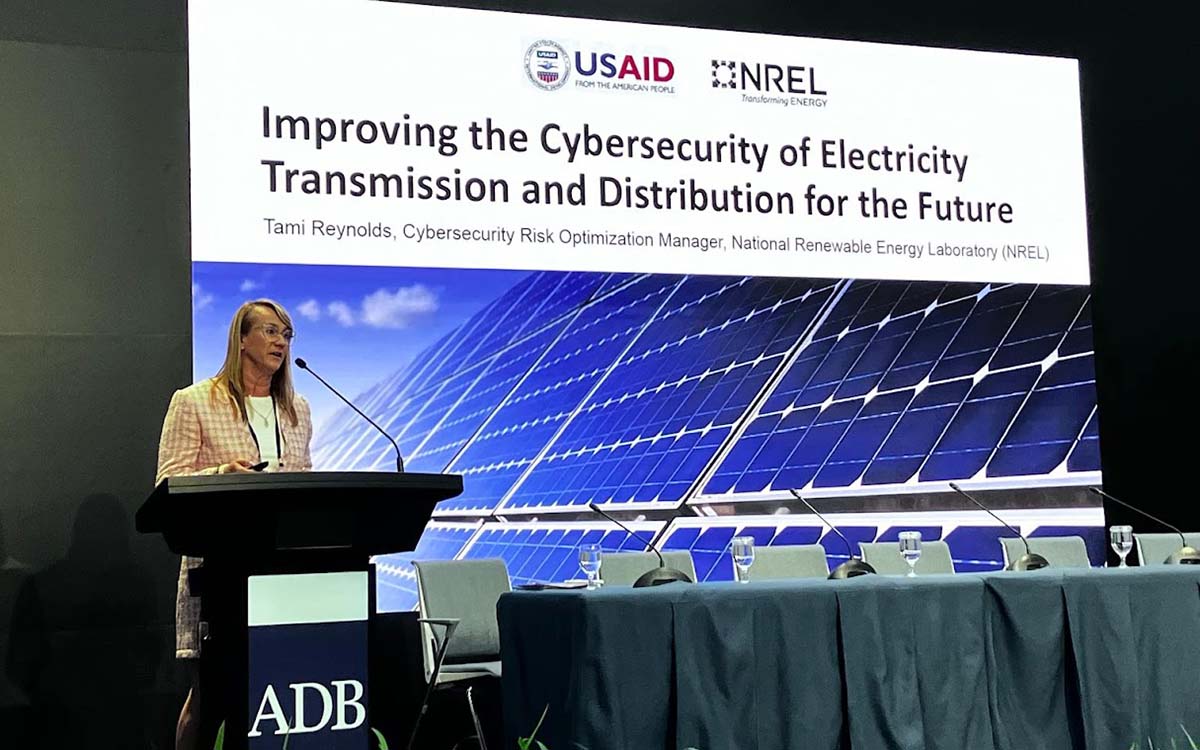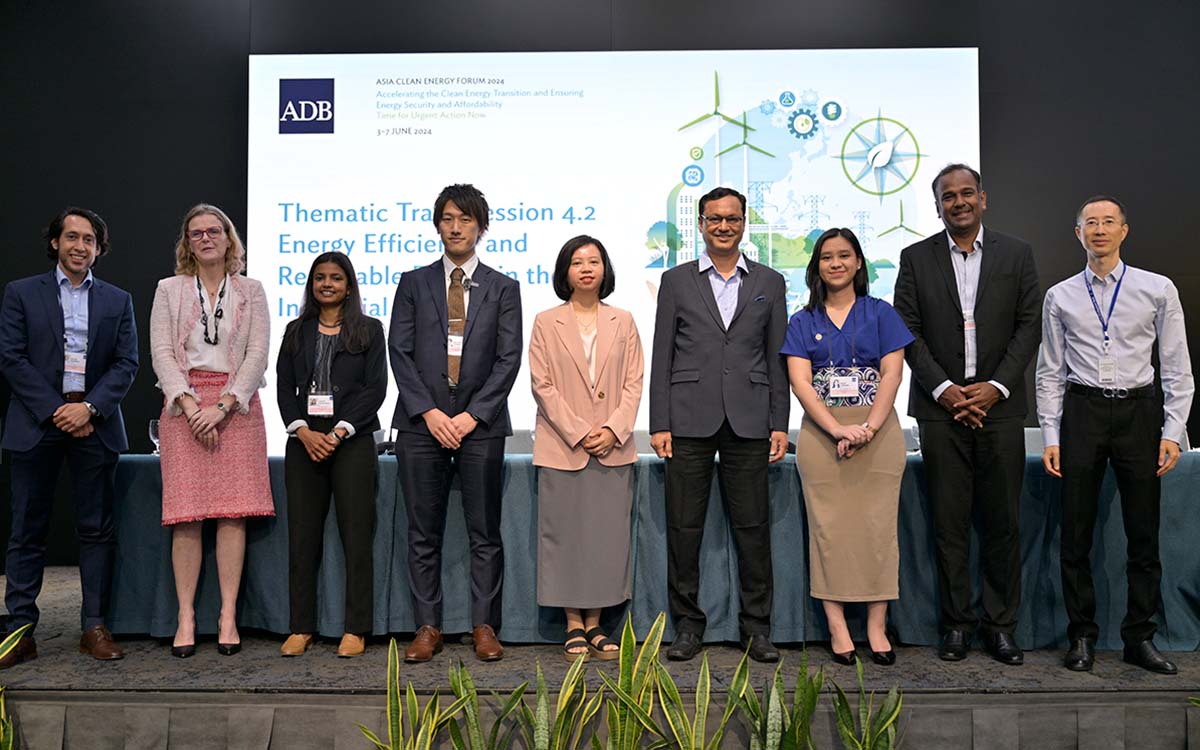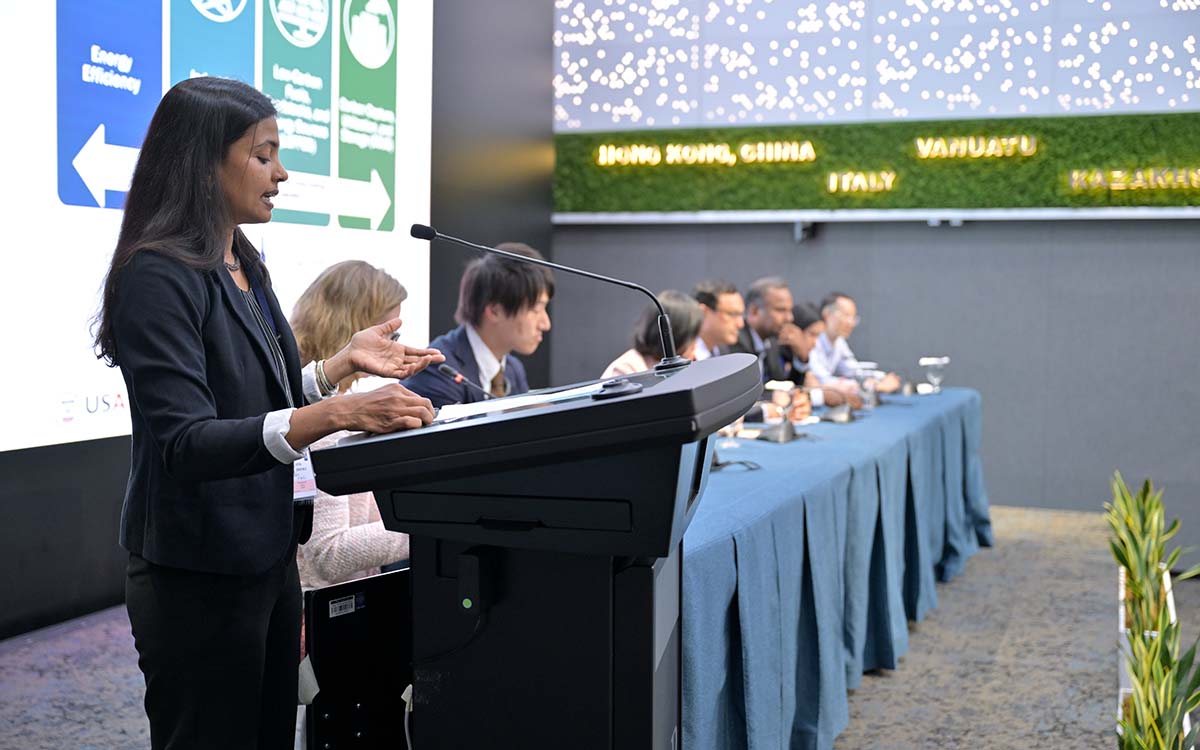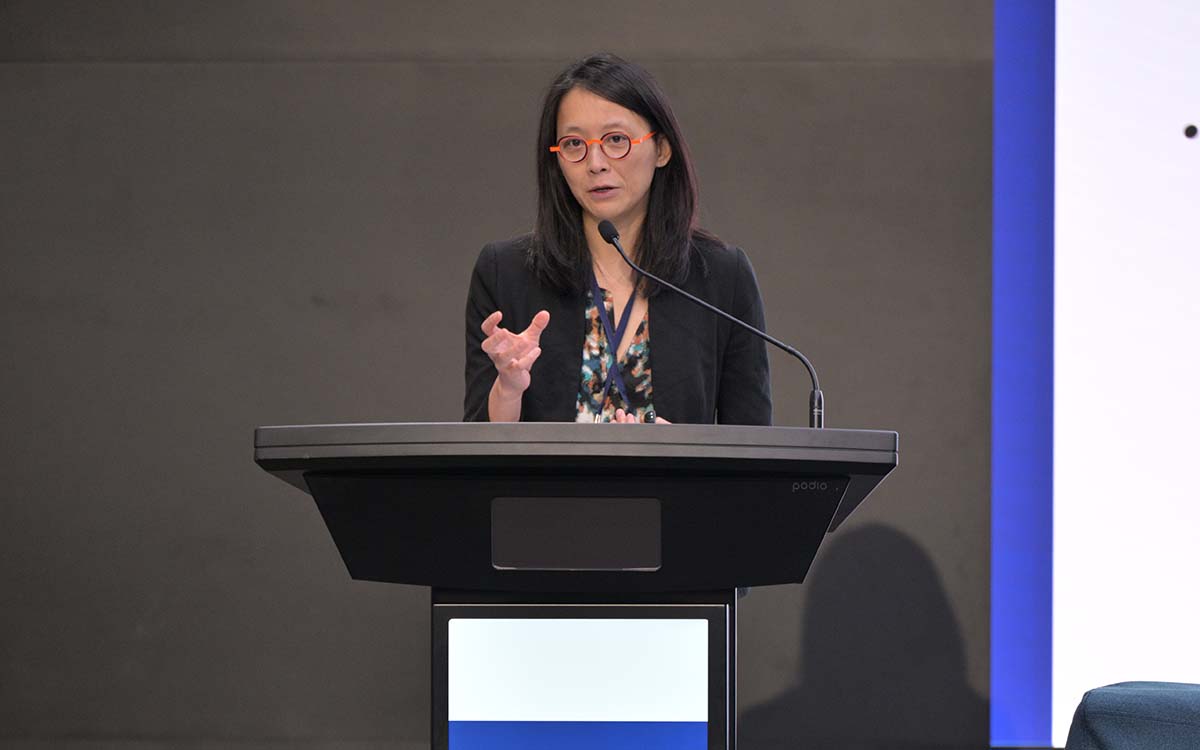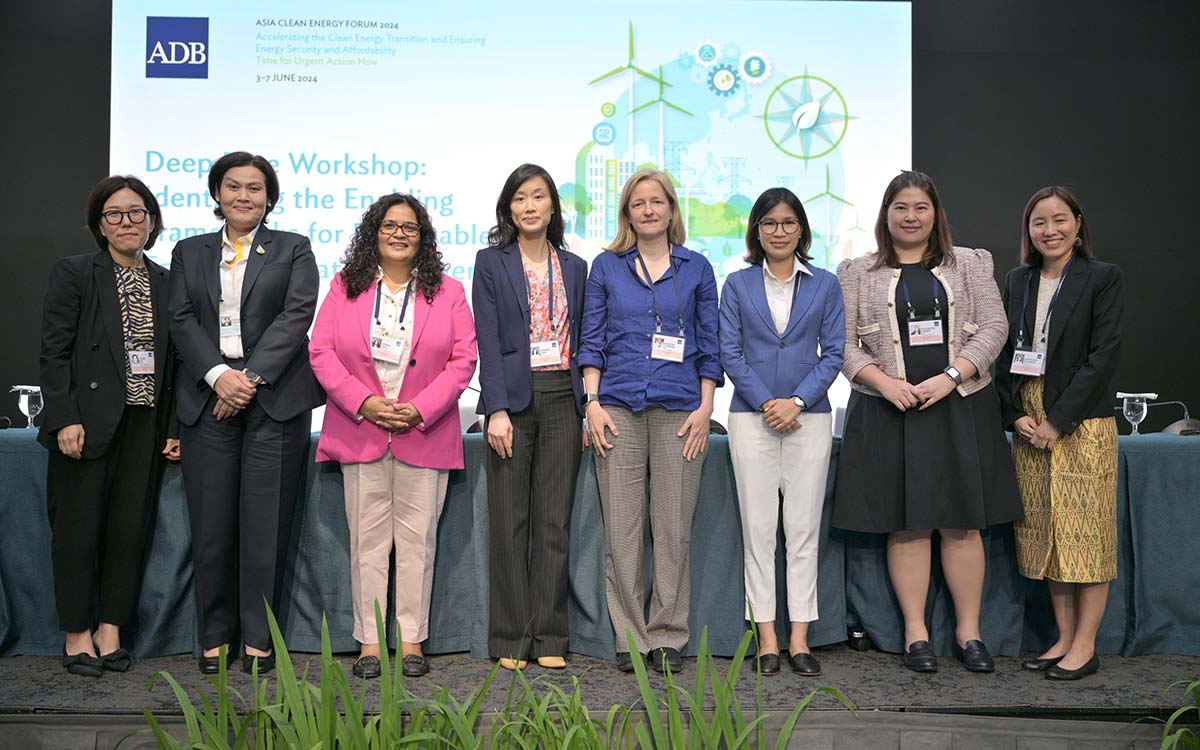The USAID and NREL Quarterly Newsletter
July 2024 Edition
This edition of the USAID-NREL Partnership newsletter highlights strides in strengthening Ukraine's energy resilience, energy planning activities in Haiti, energy efficiency standard revisions in Ecuador, and more.
Subscribe to receive this newsletter via email.
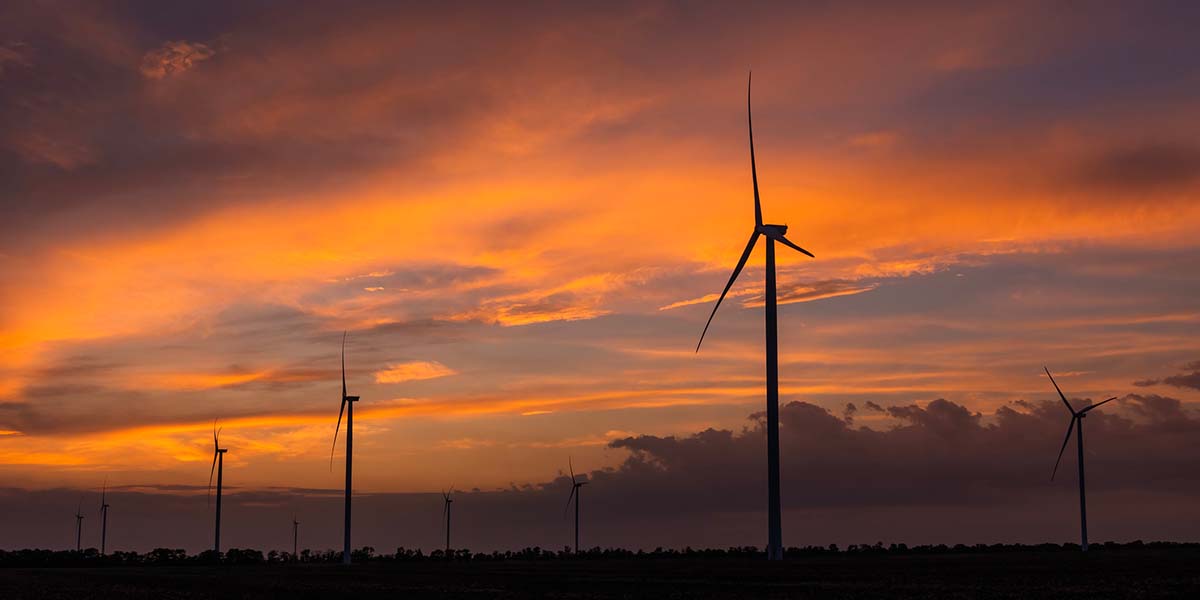
Contents
Strengthening Ukraine's Energy Resilience and Security
Support for Energy Resilience and Security in Ukraine
Agrivoltaics, Resilience, and Off-Grid Solar Support and Resources for Haiti
Takeaways From the Asia Clean Energy Forum
Planning and Operations Gap Assessment for Pakistan System Operations
Building Bhutan's Capacity To Deploy Solar PV
USAID and Berkeley Lab Advance Energy Efficiency Standard Revision for Air Conditioners in Ecuador
Demand Side Management Strategies to Mitigate South Africa’s Electricity Crisis
Tools and Resources for Real World Problem-Solving: Olive From Energy First Services
Strengthening Ukraine's Energy Resilience and Security
As we witness the rapid evolution of energy systems globally, the importance of building resilient and secure power infrastructures cannot be overstated. I'm pleased to share recent progress made through the USAID-NREL Partnership in Ukraine to support development of renewable energy and distributed energy resources (DERs).
Over the past year, our work has centered on partnering with Ukrainian stakeholders to enhance the resilience of their power systems. NREL recently released high-resolution wind data to inform energy strategies and advance sustainable development goals. To bolster community resilience against power interruptions, the USAID-NREL partnership also conducted an in-depth techno-economic analysis for a microgrid in Merefa, as well as providing technical assistance to measure the impact of integrating renewable energy at the Children's Rehabilitation Center in Chortkiv. This initiative is crucial not only for meeting immediate energy needs but also for ensuring a sustainable and secure energy future as Ukraine plans for post-war recovery and rebuilding.
The collaboration began with extensive stakeholder engagement, working closely with communities to understand their unique needs and identify effective solutions for increased resilience through clean energy. By involving local utilities, municipal authorities, community leaders, and local private enterprises, we ensured that our interventions were tailored to address specific challenges and leverage local strengths. This inclusive approach has been instrumental in fostering a sense of ownership and commitment among all parties involved.
One of our notable achievements was the initiation of a pilot project aimed at developing a community microgrid that integrates solar and energy storage solutions to enhance the resilience of crucial local businesses. By ensuring these businesses can continue operating during grid outages, the microgrid not only supports economic security but also enhances the resilience of the community. Additionally, the deployment of energy storage systems will help balance the local grid during normal operations, manage peak loads, and improve overall grid stability.
In addition, we are helping with expert assistance and pre-feasibility studies of DERs and clean energy microgrids for critical facilities such as hospitals. These microgrids ensure that essential services remain operational during grid outages, thereby safeguarding public health and safety. The implementation of these resilient microgrids is a significant step toward creating reliable and secure energy infrastructure in Ukraine.
The Government of Ukraine has recognized the resilience benefits of wind energy, which is inherently more geographically distributed than conventional thermal power plants. Wind turbines are less vulnerable to kinetic attacks, making them a secure option for maintaining continuous power supply during conflicts. This strategic advantage has made wind energy a cornerstone of Ukraine's energy resilience strategy.
NREL created and publicly released high-quality wind and solar resource data covering all of Ukraine. This data is essential for planners, developers, and investors, as it provides the detailed information needed to optimize the deployment of renewable energy projects across the country. By making this data publicly available, we are empowering local and international stakeholders to contribute to Ukraine's recovery and rebuilding efforts.
A key component of our strategy has been capacity building. Over the past year, we conducted a series of “train the trainer” workshops and knowledge-sharing sessions with Ukrainian energy professionals. These sessions focused on getting NREL tools and datasets into the hands of engineers and energy professionals on the ground. The enthusiastic participation and commitment of local stakeholders have been truly inspiring.
Our efforts in Ukraine underscore the critical role of international partnerships in advancing global energy security and resilience. By combining local expertise with our technical knowledge and resources, we can achieve significant progress toward a cleaner and more resilient energy future. If you are interested in learning more about this work, explore the resources shared in this newsletter, and visit our USAID-NREL Ukraine webpage.
I am grateful for the hard work of our partners in Ukraine, the support of USAID, and the dedication of our team at NREL. We look forward to building on these accomplishments and driving further advancements for Ukraine's secure energy future.
Best regards,

Ilya Chernyakhovskiy
NREL Lead for Support to Ukraine, USAID-NREL Partnership
Group Manager, Capacity Expansion, Grid Planning and Analysis Center
Featured News
Support for Energy Resilience and Security in Ukraine
High-Resolution Wind Data
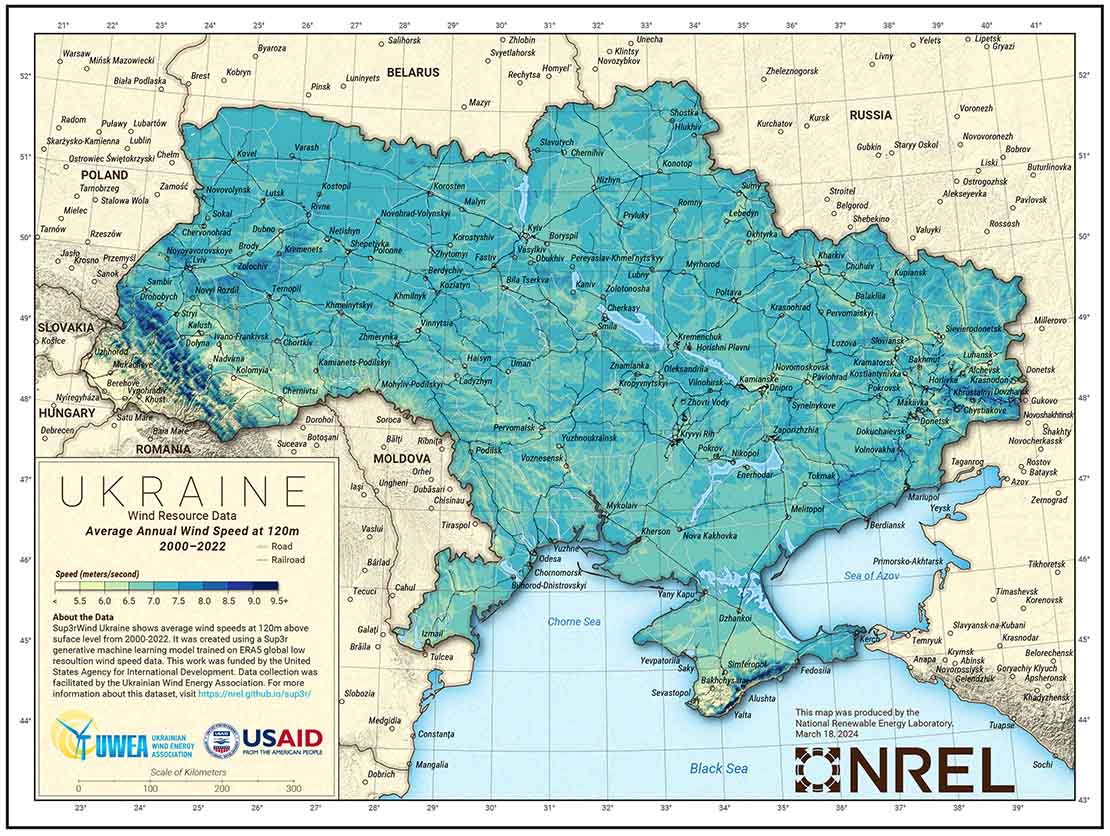
Average annual wind speed at 120m for Ukraine, 2000-2022. Image by Billy Roberts, NREL
NREL released publicly available, high-resolution wind data for all of Ukraine. Building on existing data and models, NREL researchers overcame the computational challenges that had been a barrier to producing long-term wind resource data sets. The team used the super resolution for renewable energy resource data (sup3r) framework to achieve results that are competitive with conventional dynamical downscaling in a fraction of the time. This wind data, as well as solar data released earlier this year, are available at no cost through the RE Data Explorer. To learn more, watch the Wind and Solar Data for Renewable Energy in Ukraine webinar on YouTube, where NREL's experts walked professionals, researchers, and policymakers through this data to help optimize energy strategies and support sustainable development goals.
Merefa Clean Energy Microgrids in Ukraine
To enhance community resilience against power interruptions, NREL's team conducted a comprehensive techno-economic analysis for a microgrid in Merefa. This analysis assessed system component capacities, lifecycle costs, and the probability of serving critical loads and created an operational sequence for the microgrid. This analysis is a crucial component for securing financing to implement the Merefa microgrid project and aligns with Ukraine's Energy Strategy for 2050, supporting the deployment of DERs and providing clean and sustainable energy solutions. Explore the presentation deck outlining this analysis.
Techno-Economic Modeling of Distributed Energy Resource Systems for Chortkiv Children's Rehabilitation Center and Chervonohrad Water Utility
In Ukraine, NREL also provided technical assistance to quantify the impact of integrating renewable energy at the Children's Rehabilitation Center in Chortkiv. This assistance included techno-economic modeling of solar PV and battery energy storage, identifying the achievable renewable energy contribution while considering physical constraints and solar resources.
NREL performed a separate techno-economic analysis for the water utility in Chervonohrad, Ukraine, to size and estimate the economic and technical potential for solar photovoltaic and battery energy storage systems. Analyses results are presented for three pumping stations at Pravda, Bendiuga, and Mezhyricha. Learn more by reading the full Chervonohrad analysis.
These studies will guide both the Children's Rehabilitation Center in Chortkiv and the water utility in Chervonohrad with designing and installing the necessary equipment and can be used as tools to seek funding partners or release a request for proposals from qualified developers.
Agrivoltaics, Resilience, and Off-Grid Solar Support and Resources for Haiti
Haiti's power sector is vulnerable to disruption from both social unrest and natural disasters, which can affect both economic growth and quality of life. NREL collaborated with Haitian authorities to build resilience in energy planning through workshops on the USAID-NREL Resilient Energy Platform. These workshops equipped government officials to proactively identify vulnerabilities and develop mitigation strategies. NREL also developed a modeling framework and online training series for using the ENGAGE tool for strategic energy sector planning.
To improve energy access, Haiti is expanding solar mini grids in rural areas. However, often the best areas for solar are good areas for agriculture. Agrivoltaics, which combines agriculture with solar energy production, offers a solution by allowing crops and livestock to coexist with solar panels. NREL's feasibility analysis and stakeholder engagement report assessed the potential for agrivoltaics in Haiti providing an overview of key considerations for pilot projects to balance energy needs, agricultural production, community support, and financial sustainability.
Additionally, the USAID-NREL Partnership worked with the Universite d'Etat d'Haiti Faculté des Sciences and other stakeholders to develop an 11-module training curriculum covering the foundations of off-grid solar in Haiti. This self-paced course covers solar products and quality standards, system design, business models, powering livelihoods, gender equity, and more. Explore the resources from across this work on the USAID-NREL Haiti webpage.
Takeaways From the Asia Clean Energy Forum
Over 1,200 industry leaders and experts convened at the Asia Clean Energy Forum in June 2024 with the common goal of accelerating the clean energy transition and ensuring energy security across the Asia-Pacific region. Cosponsored by the Asian Development Bank and USAID, this conference covered critical topics such as enabling multilateral power trade through market, governance, and technical innovations; enhancing energy security by planning for cyber security threats and supply chain disruptions; and technical solutions to increase variable renewable penetration. Attendees gained insights from peer experiences across the region as well as the latest research and innovations from institutions such as NREL. The conference also celebrated the pivotal contributions of women in transforming the power sector while delving into advanced grid management techniques, innovations driving industrial carbon reduction, and approaches to achieving cost-effective power system flexibility.
The conference, which came at the end of a multi-week heatwave across South and Southeast Asia, raised the urgency of addressing climate change. Many of the representatives attending the conference shared technical challenges related to transmission planning and development, grid operations, scaling up and securing clean energy projects, and financing. The USAID-NREL team shared research and tools to address several of these topics, including industrial decarbonization opportunities, NREL's distributed energy resources cyber framework, community-based approaches to building innovation, and variable renewable energy firming strategies.
For more of NREL's research and analysis with USAID's Regional Development Mission for Asia mission and partners, visit our Advanced Energy Partnership for Asia web page.
Planning and Operations Gap Assessment for Pakistan System Operations
Pakistan aims to reduce emissions by 50% and source 60% of the country's energy from renewables by 2030. According to the World Bank, Pakistan has immense potential for solar and wind energy and could use just 0.071% of the nation's land to generate the solar photovoltaic power needed to meet current electricity needs. However, the country faces challenges with overloaded grid stations and frequent blackouts.
To support Pakistan's energy transition, NREL conducted interviews with National Power Control Center experts over the course of five months. The National Power Control Center is a contracting organization with a charter that encompasses the management of power projects on a turnkey basis. This includes Extra High Voltage Transmission Lines, Distribution Networks, Substations, Power Generation Plants, Industrial Electrification, and External Lighting of Housing Complexes. The resulting report (forthcoming) provides insights into current practices and offers suggestions to improve planning, operating practices and reserves, helping to enhance the security, resilience and efficiency of Pakistan's power system. Learn more about NREL's partnership with USAID in Pakistan by visiting the USAID-NREL Pakistan webpage.
Building Bhutan's Capacity To Deploy Solar PV
Bhutan's energy system, primarily reliant on hydropower, faces challenges with reduced hydroelectric resources during dry winter months and risks from climate change affecting water resources. Through the South Asia Group for Energy, the USAID-NREL Partnership is supporting Bhutan in deploying photovoltaic solar energy to bolster climate and energy resilience. Partnering with the South Asia Group for Energy enables Bhutan's power generator, Druk Green Power Corp., and the transmission and distribution utility, Bhutan Power Corp., to enhance their solar capabilities and integrate solar energy into the grid. By diversifying its energy mix and incorporating solar power, Bhutan's energy infrastructure is stronger against the risks of seasonal variations and climate change, thereby improving the reliability and resilience of its energy system. Learn more about the South Asia Group for Energy's work in Bhutan.
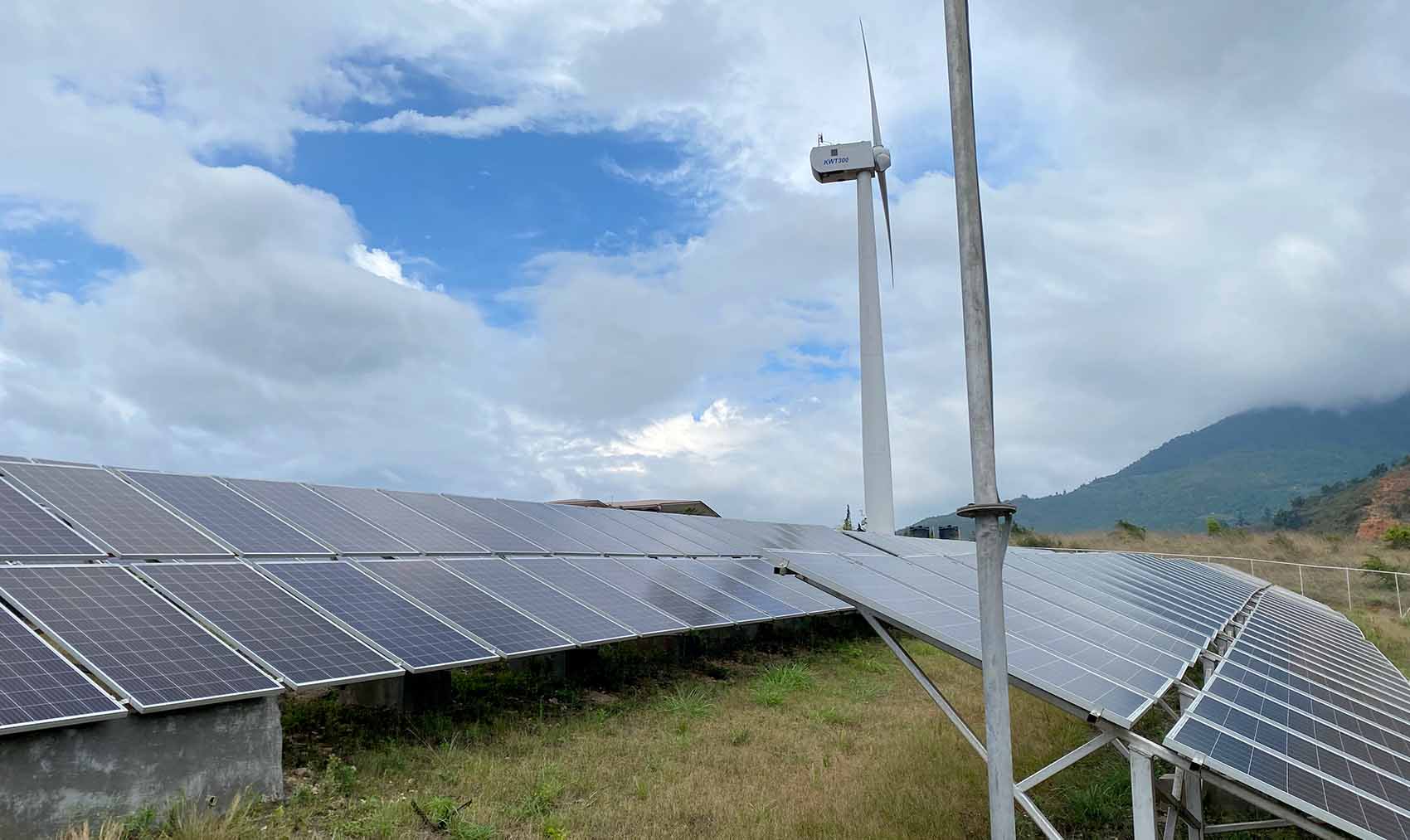
Solar and wind site near Paro, Bhutan. Photo by Andy Walker, NREL
USAID and Berkeley Lab Advance Energy Efficiency Standard Revision for Air Conditioners in Ecuador
A new analysis led by Berkeley Lab, with support of USAID's Energy Efficiency for Development program (EE4D), shows how updates to Ecuador's air conditioner (AC) performance standards can greatly reduce energy consumption. AC imports increased by approximately 12% annually between 2015 and 2020, nearly doubling over the five-year period. While the rising use of AC-powered devices exacerbated Ecuador's energy shortage crisis, it also presents a significant opportunity for addressing the issue. Revisions to Ecuador's current minimum energy performance standard could achieve an avoidance of generation capacity of 240 MW by 2035, and 460 MW by 2045. This initiative aims to lower energy costs for homes and small businesses while avoiding expensive barge-mounted, natural gas-powered generators. The Ministry of Mines and Energy is currently evaluating proposals to contract 438 MW of new electricity generation, with a reference budget of $498 million.
The results of the analysis were presented at a “Cooling Summit” held in Quito on Nov. 15, 2023, an event organized by USAID, Berkeley Lab, and Ecuador's Ministry of Production, Foreign Trade, Investment and Fisheries and attended by representatives of government agencies, HVAC industry, and the cooling research community.
The report provides a technical assessment supporting the revision and update of the minimum energy performance standard for air conditioners in Ecuador, which was set in 2013. Ecuador is currently grappling with an electricity crisis stemming from diminished hydropower capacity during the dry season. In response to this challenge, EE4D's technical assistance program is promoting energy efficiency as a key strategy to mitigate the power sector's vulnerability. The severity of the situation was underscored when President Daniel Noboa declared an energy emergency and appointed an interim energy minister. These actions were taken in direct response to the drought's significant impact on the nation's hydroelectric power generation.
By focusing on energy efficiency, the EE4D initiative aims to help Ecuador build resilience in its power sector, reducing the country's susceptibility to climate-related energy shortages and supporting long-term energy security. Learn more about EE4D's work in Ecuador on the EE4D website.
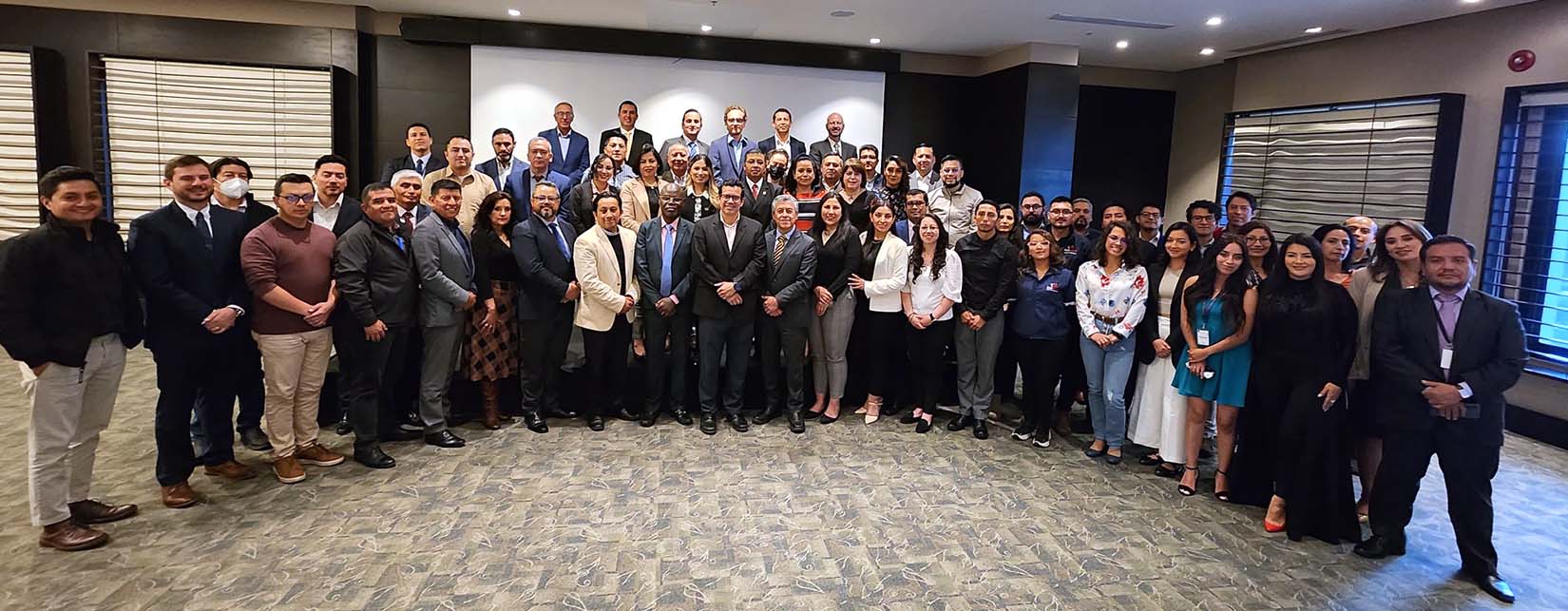
Demand Side Management Strategies To Mitigate South Africa's Electricity Crisis
USAID and Berkeley Lab's Demand Side Management project released a new study on electric water heaters that looks at ways to improve power use and reduce peak load stress on South Africa's energy grid. The country is facing a serious electricity crisis, with frequent and long rolling blackouts happening daily. The study, done in collaboration with the University of the Witwatersrand and the Department of Mineral Resources and Energy, gives policymakers actionable, evidence-based recommendations backed by carefully developed scenarios.
The study identifies various technologies to reduce energy use and estimates the impact of the selected measures. It found that the maximum demand for water heating was 6,643 MW in 2023 during winter, with this demand expected to increase to 7,478 MW by 2033, which is almost an increase equivalent to one stage of load shedding (1,000 MW). This suggests that without intervention, the grid will face even more severe issues in the next decade. The study analyzed 10 technologies and simulated five measures to see their impact on energy and demand reduction. The study concludes that a comprehensive policy package is needed that combines different strategies, regulations, incentives, and enforcement mechanisms to manage load and reduce energy consumption effectively. The study team is presenting these recommendations to the Department of Mineral Resources and Energy and working with municipalities to conduct pilot interventions to test the different policy packages for future national scale up policies implementation.
The data-backed recommendations from the Demand Side Management project are part of technical assistance to help the South African government reduce energy demand and optimize load management. To learn more, explore the study's executive summary and full report.
Tools and Resources for Real World Problem-Solving:
Olive From Energy First Services
Meet Olive Mutsawashe Mushoriwa from Zimbabwe, a renewable energy engineer at Energy First Limited. Olive uses the RE Data Explorer tool to access solar data for the entire African continent, allowing her to perform prefeasibility and site selection assessments. While her primary focus is on solar projects in Zimbabwe, she also supports renewable energy initiatives in South Africa and Zambia, striving to develop as many projects as possible. These projects are crucial for integrating into the grid and utility companies as well as aiding plants and mines in transitioning off-grid.
In addition to the RE Data Explorer, Olive leverages advanced software tools such as the System Advisor Model, the Hybrid Optimization of Multiple Energy Resources Model, and Helioscope to drive numerous early-stage projects forward.
Meet the Team—Ahni Hecht

Ahni Hecht is a project manager in NREL's Accelerated Deployment and Decision Support Center. She helps lead partnerships and initiatives aimed at delivering clean, affordable, and equitable power in economically developing countries. She currently works as the USAID-NREL Operations Manager.
Tell us more about your role on the USAID-NREL Partnership. What does it entail?
As the operations manager of the USAID-NREL Partnership, I collaborate with country
partners worldwide to help them achieve their clean energy goals. I work with a cross-lab
technical team to identify opportunities where NREL and the broader U.S. Department
of Energy (DOE) laboratory can support energy transition challenges. My role also
involves ensuring my team has everything they need to succeed. Additionally, I focus
on elevating the story of our impact by communicating our deeply technical work to
non-technical audiences.
What inspires you to work on international projects such as the USAID-NREL Partnership?
For me, it's all about the people we get to partner with. I love building connections
and learning from the diverse experiences of others; it provides a fresh perspective
on life. I am also inspired daily by the amazing team at NREL. Their brilliance and
commitment are reflected in the exceptional work they do.
Tell us about a project that you are really excited about right now and why?
All the projects we work on are exciting! However, my passion lies in being able to
learn about and communicate the impact of the work we do. It is motivating to learn
that the deeply technical research, tools, and analysis that we do at the lab can
have a tangible impact on someone's life. We recently launched an Impacts webpage
where we can better share these stories with the world.
Why is it important to work with other countries around the world on deploying advanced
and sustainable power systems?
Given the urgency of transitioning to clean energy, it's crucial to leverage our investments
in lab capabilities and technologies and share them globally. This enables our partner
countries to adopt these technologies quickly and on a large scale. Additionally,
NREL can learn a lot from the international community. It's exciting to see this exchange
of ideas lead to new ways of thinking and approaching solutions.
If you could give any advice to young or early-career persons, what would it be?
My advice to young or early-career individuals, if they are able, is to travel and
learn about different cultures and ways of doing things. Embrace opportunities that
push you out of your comfort zone, as these are often the most rewarding. Also, stay
passionate about your work, and remember the impact you can make on the world.
Finally, tell us a little bit about yourself. How do you like to spend your time outside
of work?
I live in the mountains at about 9,000 feet (3,000 meters) and enjoy a bit of homesteading,
including maintaining a four-season greenhouse. I love walking around my neighborhood
and wildcrafting, harvesting edible and medicinal plants that grow in the mountains.
When I venture into town, it's usually for dancing, especially to salsa, cumbia, bachata,
or the occasional concert.
Resource Round Up
Find all the publications, recordings, and resources outlined in this newsletter, and more, at a glance.
Must Read
International Applications for Floating Solar PV (FPV), NREL Presentation (2024)
Merefa Community Microgrid: Conceptual Design and Sequence of Operations, NREL Presentation (2024)
Technical and Economic Screening for Potential of Distributed Energy Resource Integration at Chervonohrad Water Utility in Ukraine, NREL Technical Report (2024)
Tangible Solutions for Grid Operation Upgrade, NREL Presentation (2024)
South Asia Group for Energy - Bhutan, NREL Fact Sheet (2024)
USAID and Berkeley Lab Advance Energy Efficiency Standard Revision for Air Conditioners in Ecuador, EE4d webpage
Residential Water Heating Demand Side Management - South Africa – Executive Summary, Lawrence Berkeley National Laboratory Technical Report (2024)
Residential Water Heating Demand Side Management - South Africa – Full Report, Lawrence Berkeley National Laboratory Technical Report (2024)
Must Watch on YouTube
Offshore Wind Energy Fundamentals for Bangladesh
Wind and Solar Data for Renewable Energy Development in Ukraine
Share

